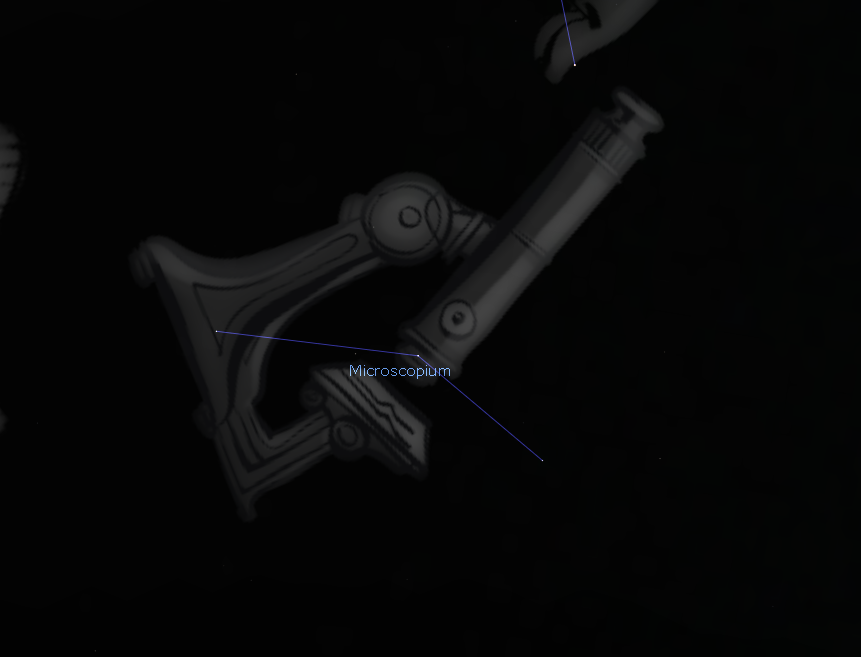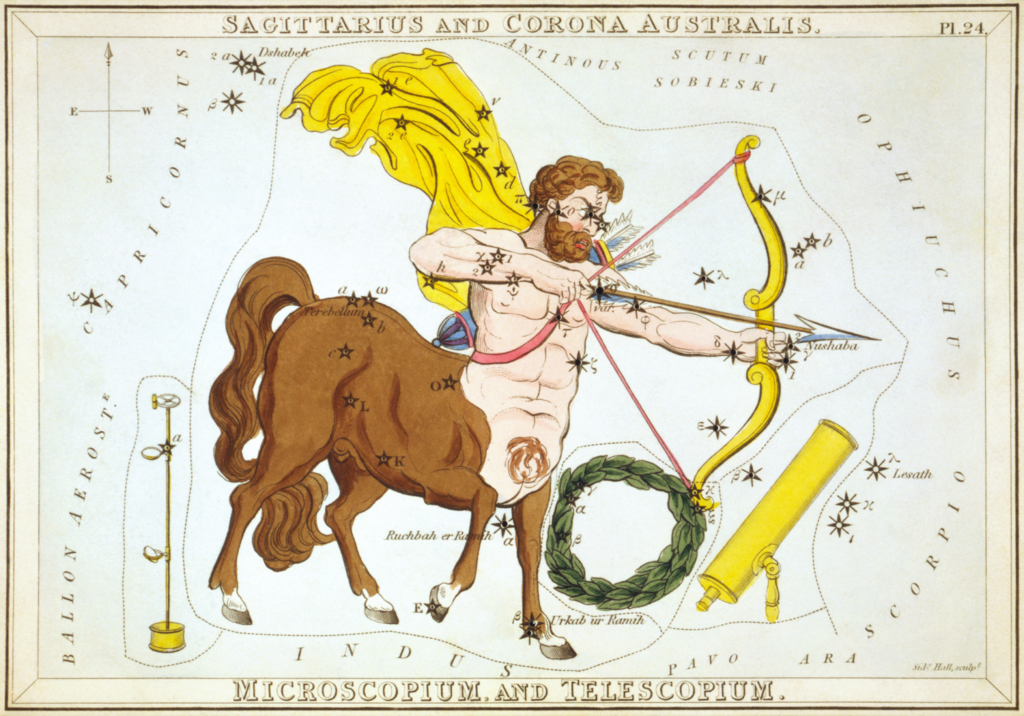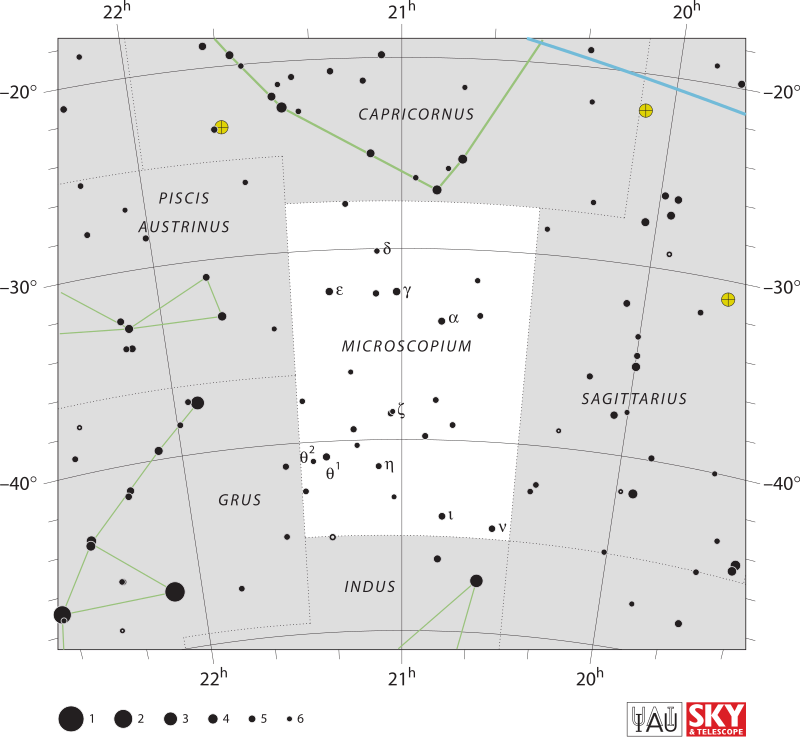|
One of the twelve constellations Nicolas-Louis de Lacaille, a French astronomer, named Microscopium ("the Microscope") in the 18th century. It is a small constellation in the southern celestial hemisphere. The word for microscope in Greek is transformed into Latin by the name. Most of the Northern Hemisphere's non-tropical regions cannot see its stars because they are so dim.
Gamma Microscopii, a yellow giant 2.5 times the mass of the Sun that is approximately 223 8 light-years away, is the brightest star in the constellation with an apparent magnitude of 4.68. It may have disturbed the outer Solar System as it passed the Sun between 1.14 and 3.45 light-years away 3.9 million years ago. There are planets in two-star systems—WASP-7 and HD 205739—and debris discs in two more—the youthful red dwarf star AU Microscopii and the sun-like HD 202628. A wide triple system and members of the Beta Pictoris moving group, AU Microscopii and the binary red dwarf system AT Microscopii are most likely. BO Microscopii, often known as "Speedy Mic," is a star with an incredibly quick rotational period of 9 hours, and 7 minutes. |
Characteristics
A minor constellation called Microscopium is bounded to the north by Capricornus, to the east by Piscis Austrinus and Grus, to the east by Sagittarius, to the south by Indus, and to the southwest by Telescopium. The International Astronomical Union selected "Mic" as the standard three-letter acronym for the constellation in 1922. (Russell 1922) Eugène Delporte, a Belgian astronomer, established the official constellation limits in 1930, which are represented by a polygon with four parts. These borders have right ascension coordinates between 20h 27.3m and 21h 28.4m in the equatorial coordinate system, and declination coordinates between 27.45° and 45.09°. Observers south of latitude 45°N can see the entire constellation. The constellation is not visible to the human eye in light-polluted skies because its brightest stars are of fifth magnitude. (Kambič 2009)
A minor constellation called Microscopium is bounded to the north by Capricornus, to the east by Piscis Austrinus and Grus, to the east by Sagittarius, to the south by Indus, and to the southwest by Telescopium. The International Astronomical Union selected "Mic" as the standard three-letter acronym for the constellation in 1922. (Russell 1922) Eugène Delporte, a Belgian astronomer, established the official constellation limits in 1930, which are represented by a polygon with four parts. These borders have right ascension coordinates between 20h 27.3m and 21h 28.4m in the equatorial coordinate system, and declination coordinates between 27.45° and 45.09°. Observers south of latitude 45°N can see the entire constellation. The constellation is not visible to the human eye in light-polluted skies because its brightest stars are of fifth magnitude. (Kambič 2009)
|
History
The area where the stars of Microscopium are located was formerly thought to be the back foot of the nearby constellation Sagittarius. (Rubie 1830) According to John Ellard Gore, al-Sufi appears to have stated that Ptolemy had seen the stars, but he (Al Sufi) did not specify where they were located. After seeing and cataloguing 10,000 southern stars over the course of a two-year stay at the Cape of Good Hope, Lacaille invented the Microscopium in 1751–1752 under the French name le Microscope. In unexplored areas of the Southern Celestial Hemisphere that were obscured from Europe, he created fourteen new constellations. All but one of them recognised the artefacts of the Age of Enlightenment. (Wagman 2003) In honour of the compound microscope, Lacaille's Latinization of the word Microscope to Microscopium occurred by 1763. |
Deep-sky Objects
NGC 6925 – Barred Spiral Galaxy
SN 2011ei – Type 2 supernova situated in NGC 6925
NGC 6923 – Barred Spiral Galaxy
Microscopium Supercluster – multiple large clusters of galaxies
Main stars - 5
Bayer stars - 13
Stars with planets - 2
Stars brighter than magnitude 3.00 - 0
Stars within 32 Ly - 2
Meteor showers
Microscopids – Minor Meteor shower June to Mid-July
Bordering
constellations
NGC 6925 – Barred Spiral Galaxy
SN 2011ei – Type 2 supernova situated in NGC 6925
NGC 6923 – Barred Spiral Galaxy
Microscopium Supercluster – multiple large clusters of galaxies
Main stars - 5
Bayer stars - 13
Stars with planets - 2
Stars brighter than magnitude 3.00 - 0
Stars within 32 Ly - 2
Meteor showers
Microscopids – Minor Meteor shower June to Mid-July
Bordering
constellations
- Capricornus
- Sagittarius
- Telescopium
- Indus
- Grus
- Piscis Austrinus


